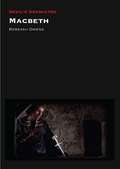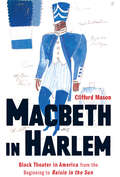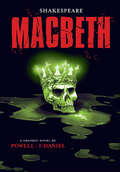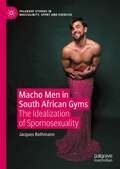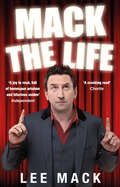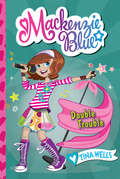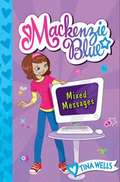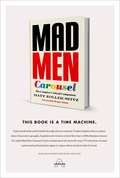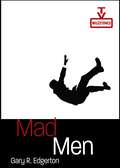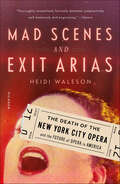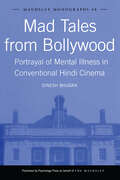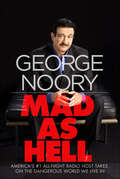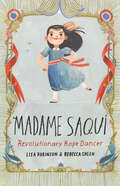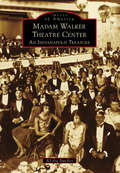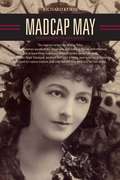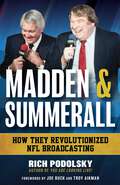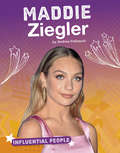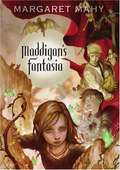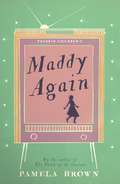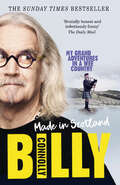- Table View
- List View
Macbeth (Devil's Advocates)
by Rebekah OwensWhy write about Roman Polanski's Macbeth (1971) as part of a series of books dedicated to the classics of the horror movie genre? Because, Rebekah Owens argues, just as Banquo in Polanski's film holds up a series of mirrors that reflect images of his successors that trace back to his own son Fleance, so subsequent milestones in the genre show their lineage to this work, their originator. Polanski had previously made Repulsion (1965) and Rosemary's Baby (1968), so he was fully aware of the conventions of the horror genre and this film provides clues to his own horror lexicon.This book demonstrates how Macbeth can be read as part of the British Folk tradition, strengthening the reading of the film as a horror movie in its own right through its links to The Wicker Man (1973), Blood on Satan's Claw (1971) and Witchfinder General (1968) then argues the case for its recognition as a horror movie even further, by connecting it to the later American horror classics, such as Halloween (1978). It also explores the popular associations made between the film and Polanski's own life, arguing that they endorse the view of the film as a horror. This book represents the first serious attempt to regard Polanski's Macbeth as a horror film in its own right, and not exclusively as one of a multitude of ongoing Shakespeare film adaptations.
Macbeth in Harlem: Black Theater in America from the Beginning to Raisin in the Sun
by Clifford MasonIn 1936 Orson Welles directed a celebrated all-black production of Macbeth that was hailed as a breakthrough for African Americans in the theater. For over a century, black performers had fought for the right to perform on the American stage, going all the way back to an 1820s Shakespearean troupe that performed Richard III, Othello, and Macbeth, without relying on white patronage. "Macbeth" in Harlem tells the story of these actors and their fellow black theatrical artists, from the early nineteenth century to the dawn of the civil rights era. For the first time we see how African American performers fought to carve out a space for authentic black voices onstage, at a time when blockbuster plays like Uncle Tom’s Cabin and The Octoroon trafficked in cheap stereotypes. Though the Harlem Renaissance brought an influx of talented black writers and directors to the forefront of the American stage, they still struggled to gain recognition from an indifferent critical press. Above all, "Macbeth" in Harlem is a testament to black artistry thriving in the face of adversity. It chronicles how even as the endemic racism in American society and its theatrical establishment forced black performers to abase themselves for white audiences’ amusement, African Americans overcame those obstacles to enrich the nation’s theater in countless ways.
Macbeth: A Graphic Novel
by William Shakespeare Martin PowellThe epic tale of Macbeth retold in graphic-novel format. Macbeth and Banquo are Scottish generals returning home from a victorious war campaign. Their journey is interrupted when three strange witches come upon them and predict their futures. They claim that Macbeth will one day become King of Scotland! Macbeth is stirred by the prophesy. With the help of his scheming wife, he sets into motion a sinister plan that will paint bloody strokes across the entire landscape of Scotland.
Macbeth: A Graphic Novel
by William Shakespeare Martin PowellThe epic tale of Macbeth retold in graphic-novel format. Macbeth and Banquo are Scottish generals returning home from a victorious war campaign. Their journey is interrupted when three strange witches come upon them and predict their futures. They claim that Macbeth will one day become King of Scotland! Macbeth is stirred by the prophesy. With the help of his scheming wife, he sets into motion a sinister plan that will paint bloody strokes across the entire landscape of Scotland.
Macho Men in South African Gyms: The Idealization of Spornosexuality (Palgrave Studies in Masculinity, Sport and Exercise)
by Jacques RothmannThis book explores the experiences of self-identified heterosexual and gay men in contemporary South African gym contexts, particularly as it relates to how the intersection of spornosexual and inclusive masculinities inform their views and enactment of their masculine and sexual identities. Chapters engage with findings from an in-depth qualitative sociological exploration on issues surrounding these masculinities among men living in South Africa who engage in gym work. The author demonstrates that men, when given the opportunity to reflect on their own and the masculinity of others, acknowledge how they promote softer, kinder, disciplined, playful, and sexually agentic masculinities through their look and touch.
Mack The Life: Enhanced Edition
by Lee Mack‘His book is a joy to read, full of homespun wisdom and hilarious asides’ Independent____________________Where do comedians come from? Why is it that one person is a funny bloke down the pub while another actually makes a living by standing up in front of an audience telling jokes? And where does all that material come from? Well, young Lee McKillop used to wonder that too.___________________ Growing up in his parents’ pub, small and wiry in a world of bigger and chunkier specimens, Lee quickly learned that cracking jokes was a way to get attention. After a somewhat random series of jobs, which included being Red Rum’s stableboy and a bingo hall barman, it was as a Great Yarmouth holiday camp entertainer that he had his first crack at telling jokes on stage. It got him some laughs, the sack and a punch in the face.*Now, as Lee Mack, he’s one of our best loved and most successful comedians, both as a live stand-up and on television. In Mack the Life, Lee tells the story of how he got there and gives extraordinary insight into what really makes comics tick. Hilarious and brilliant, it’s the kind of book which reminds you why you learned to read in the first place.*Nearly.
Mackenzie Blue #5: Double Trouble
by Tina Wells Michael SegawaMackenzie Blue is a star! Or she will be . . . as soon as she gets the part of an aspiring singer on a new TV pilot! But juggling auditions and the rest of her life turns out to be harder than Zee thought. Zee's friends are helping her hold everything together. But Zee doesn't like having to bail on plans--and her friends--to run to another audition. Is being a star worth it?Fans of the Dork Diaries will snap up the fifth book in this tween illustrated series about a twelve-year-old girl trying to survive middle school.
Mackenzie Blue: Mixed Messages
by Tina WellsMackenzie Blue and her crew are plugged in! Zee and her band, The Beans, are getting ready for their biggest show yet! Everyone's talking about it online at Bluetopia-the coolest social-networking site ever. Top three reasons that Bluetopia is the best: I can keep all my thoughts safe in a private blog, and I won't have to worry about anyone stealing my diary (finally)! The Beans have a huge show coming up, and we can make sure everyone knows about it! Jasper (my best guy friend) is in the spotlight for creating the site. He's so talented-he deserves it.
Mad Max (Constellations)
by Martyn ConterioMad Max (1979) is a freak picture. Too classy and well-crafted to be lumped in with low-budget Ozploitation titles, yet completely unlike other films made during the 1970s Australian New Wave, George Miller’s directorial debut is a singular piece of action cinema, one that had a major cultural impact and spawned a movie icon in Max Rockatansky (played by Mel Gibson). This monograph examines the film’s considerable formal qualities in detail, including Miller’s theory of cinema as “visual rock ‘n’ roll” and his marriage of classical Hollywood editing and Soviet-style montage. George Miller is arguably the single most important filmmaker in Australia’s history, bringing a commercial and artistic vision to the screen few of his compatriots have ever managed before or since. Taking in everything from the film’s extremely controversial critical reception to its legacy today via a string of sequels and the creation of an entire subgenre—postapocalyptic action—the book is for film students and fans alike.
Mad Men Carousel: The Complete Critical Companion
by Matt Zoller SeitzMad Men Carousel is an episode-by-episode guide to all seven seasons of AMC's Mad Men. This book collects TV and movie critic Matt Zoller Seitz's celebrated Mad Men recaps--as featured on New York magazine's Vulture blog--for the first time, including never-before-published essays on the show's first three seasons. Seitz's writing digs deep into the show's themes, performances, and filmmaking, examining complex and sometimes confounding aspects of the series. The complete series--all seven seasons and ninety-two episodes--is covered. Each episode review also includes brief explanations of locations, events, consumer products, and scientific advancements that are important to the characters, such as P. J. Clarke's restaurant and the old Penn Station; the inventions of the birth control pill, the Xerox machine, and the Apollo Lunar Modu≤ the release of the Beatles' Revolver and the Beach Boys' Pet Sounds; and all the wars, protests, assassinations, and murders that cast a bloody pall over a chaotic decade. Mad Men Carousel is named after an iconic moment from the show's first-season finale, "The Wheel," wherein Don delivers an unforgettable pitch for a new slide projector that's centered on the idea of nostalgia: "the pain from an old wound. " This book will soothe the most ardent Mad Men fan's nostalgia for the show. New viewers, who will want to binge-watch their way through one of the most popular TV shows in recent memory, will discover a spoiler-friendly companion to one of the most multilayered and mercurial TV shows of all time. It's the perfect gift for Mad Men fans and obsessives.
Mad Men on the Couch: Analyzing the Minds of The Men And Women of The Hit TV Show
by Stephanie NewmanMad Men has captured the imaginations of millions of viewers, winning fifteen golden globes and four Emmys. Perhaps more than the gorgeously stylized visuals and impeccably re-created history, it's the show's richly drawn characters stumbling through their personal and professional lives that get under our skin and keep us invested.In Mad Menon the Couch, Dr. Stephanie Newman analyzes the show's primary characters through the lens of modern psychology. Lending her trained professional eye, she poses and expertly answers pressing questions such as:Why does Don constantly sabotage himself? Why is Betty such a cold mother and desperately unhappy housewife? (Hint: It's not just because her "people are Nordic.")Why does Pete prevail in adversity when Roger crumbles?Why is Peggy able to rise profesionally in the male jungle of Madison Avenue when Joan can't?Can these characters ever really change?With critical commentary that is both entertaining and insightful, Mad Men on the Couch will provide viewers with a unique persepctive on the show.
Mad Men, Mad World: Sex, Politics, Style, and the 1960s
by Lilya Kaganovsky Robert A. Rushing Lauren M. E. GoodladSince the show's debut in 2007, Mad Men has invited viewers to immerse themselves in the lush period settings, ruthless Madison Avenue advertising culture, and arresting characters at the center of its 1960s fictional world. Mad Men, Mad World is a comprehensive analysis of this groundbreaking TV series. Scholars from across the humanities consider the AMC drama from a fascinating array of perspectives, including fashion, history, architecture, civil rights, feminism, consumerism, art, cinema, and the serial format, as well as through theoretical frames such as critical race theory, gender, queer theory, global studies, and psychoanalysis. In the introduction, the editors explore the show's popularity; its controversial representations of race, class, and gender; its powerful influence on aesthetics and style; and its unique use of period historicism and advertising as a way of speaking to our neoliberal moment. Mad Men, Mad World also includes an interview with Phil Abraham, an award-winning Mad Men director and cinematographer. Taken together, the essays demonstrate that understanding Mad Men means engaging the show not only as a reflection of the 1960s but also as a commentary on the present day. Contributors. Michael Bérubé, Alexander Doty, Lauren M. E. Goodlad, Jim Hansen, Dianne Harris, Lynne Joyrich, Lilya Kaganovsky, Clarence Lang, Caroline Levine, Kent Ono, Dana Polan, Leslie Reagan, Mabel Rosenheck, Robert A. Rushing, Irene Small, Michael Szalay, Jeremy Varon
Mad Men: Dream Come True Tv (TV Milestones Series)
by Gary R. EdgertonThis one-stop primer offers a succinct analysis of one of the most skillfully produced, artistically innovative, and culturally resonant scripted series in modern television. It opens by explaining how Mad Men (AMC, 2007–2015) functions as a representative example of much deeper and more profound structural changes happening in television since the 2000s. Gary R. Edgerton highlights influences driving the creation of the show, including creator Matthew Weiner’s personal connections to the subject matter and the development of the main character, Don Draper (Jon Hamm). Analysis of the show’s story progression is delineated by a pivotal shift from a culturally relevant Zeitgeist phenomenon to a narrative more concerned with Draper’s introspective and existential journey to reconciliation and self-awareness. Cultural reflections are also explored with interrogations of privilege and prejudice, the American Dream, ethnicity, race, gender politics, and class as witnessed through the program’s complex and conflicted characters. Following its debut, Mad Men quickly became a bellwether of contemporary culture. The award-winning series set the creative standard in drama over the span of its initial run and is now recognized as a milestone in the history and development of scripted television. Throughout its seven seasons, the series struck a delicate balance of being both complex and cerebral while also entertaining and accessible, a balance that Edgerton skillfully carries over to this book.
Mad Scenes and Exit Arias: The Death of the New York City Opera and the Future of Opera in America
by Heidi WalesonFrom the Wall Street Journal’s opera critic, a history of how and why the New York City Opera went bankrupt—and what it means for the future of the arts.In October 2013, the arts world was rocked by the news that the New York City Opera—“the people’s opera”—had finally succumbed to financial hardship after 70 years in operation. The company had been a fixture on the national opera scene—as the populist antithesis of the grand Metropolitan Opera, a nurturing home for young American talent, and a place where new, lively ideas shook up a venerable art form. But NYCO’s demise represented more than the loss of a cherished organization: it was a harbinger of massive upheaval in the performing arts—and a warning about how cultural institutions would need to change in order to survive.Drawing on extensive research and reporting, Heidi Waleson, one of the foremost American opera critics, recounts the history of this scrappy company and reveals how, from the beginning, it precariously balanced an ambitious artistic program on fragile financial supports. Waleson also looks forward and considers some better-managed, more visionary opera companies that have taken City Opera’s lessons to heart.Above all, Mad Scenes and Exit Arias is a story of money, ego, changes in institutional identity, competing forces of populism and elitism, and the ongoing debate about the role of the arts in society. It serves as a detailed case study not only for an American arts organization, but also for the sustainability and management of nonprofit organizations across the country.“An intricate whodunit that seeks to find out who murdered the New York City Opera. . . . Waleson gives us a vivid description of each death-defying crisis and a sharp portrait of the ever-changing cast of would-be saviors who somehow always failed in their mission.” —The New York Times Book Review“Thoroughly researched, factually detailed, judgmentally well-balanced, and engrossing.” —Opera“Waleson’s in-depth study illustrates the challenges City Opera—and other opera houses—face in the 21st century as they seek to preserve tradition and innovate.” —Publishers Weekly“A thorough recounting of the tumultuous history of the New York City Opera [and] a cleareyed examination of the economic fragility of cultural institutions.” —Kirkus Reviews
Mad Tales from Bollywood: Portrayal of Mental Illness in Conventional Hindi Cinema (Maudsley Series #48)
by Dinesh BhugraThis is the first book to investigate how mental illness is portrayed in Hindi cinema. It examines attitudes towards mental illness in Indian culture, how they are reflected in Hindi films, and how culture has influenced the portrayal of the psychoses. Dinesh Bhugra guides the reader through the history of Indian cinema, covering developments from the idealism of the 1950s to the stalking, jealousy and psychopathy that characterises the films of the 1990s. Critiques of individual films demonstrate the culture’s approach towards mental illness and reflect the impact of culture on films and vice versa. Subjects covered include: Cinema and emotion Attitudes towards mental illness Socio-economic factors and cinema in India Indian personality, villainy and history Psychoanalysis in the films of the 60s. Mad Tales from Bollywood will be of interest to psychiatrists, mental health professionals, students of media and cultural studies and anyone with an interest in Indian culture.
Mad as Hell: America's #1 All-Night Radio Host Takes on the Dangerous World We Live In
by George NooryAs the candidacies of Donald Trump and Bernie Sanders have proven, Americans are mad as hell about the problems facing our country. George Noory hears these problems every night, all night, and this is how he would deal with them. This is Mad as Hell.---I’m angry because sometimes I feel like a stranger in America. We live in a dangerous world that is sorely in need of an effective political system that deals with the ongoing destruction of the middle class, an aging population, permeable borders, technology out of control, and shocking, mindless violence and wars. But we can bring back the America that makes us proud. It will take hard work and pulling together as a society.People are stressed because they don’t know where the world is heading or where it is taking them. With a radio show heard by millions, I consider myself not an entertainer or someone to dictate how we should live, but a facilitator who can help guide the path chosen.I have been called a voice in the darkness. The concepts I deal with are not only on the cutting edge of science and technology, but with subjects as provocative as aliens and angels, as challenging as supervolcanos and the fire and brimstone of the End Time.Join me by reading why I am mad . . . and maybe you will get as angry as I am about conditions in the country we love.At the Publisher's request, this title is being sold without Digital Rights Management Software (DRM) applied.
Madame Saqui: Revolutionary Rope Dancer
by Lisa RobinsonA stunning picture book biography about the tightrope walker who dazzled Paris as she danced across the sky with impeccable balance and unparalleled skill during the French Revolution.In revolutionary France, a girl named Marguerite Lalanne longed to perform above large crowds on a tightrope, just like her acrobatic parents. Sneaking off to the fairgrounds for secret tightrope walking lessons, Marguerite finessed her performance skills, ultimately performing for crowds as a young rope dancer. And eventually, Marguerite would perform as Madame Saqui, waltzing and pirouetting across- and never falling off- countless ropes above adoring crowds. A nouvelle chérie de Paris, Madame Saqui cemented her place in circus history, winning the adoration of the French people and royalty alike, including Emperor Napoleon Bonaparte. This remarkable biography unveils the inspiring story of a trailblazing woman who revolutionized the circus world-- without ever missing a step.
Madame Walker Theatre Center: An Indianapolis Treasure (Images of America)
by A'Lelia BundlesAs they watched construction of the block-long flatiron building brick by brick throughout 1927, African American residents of Indianapolis could scarcely contain their pride. This new headquarters of the Madam C.J. Walker Manufacturing Company, with its terra-cotta trimmed facade, was to be more than corporate offices and a factory for what then was one of America's most successful black businesses. In fact, it was designed as "a city within a city," with an African Art Deco theater, ballroom, restaurant, drugstore, beauty salon, beauty school, and medical offices. Generations of African American families met for Sunday dinner at the Coffee Pot, enjoyed first-run movies and live performances in the Walker Theatre, and hosted dances in the Casino. Today, this National Historic Landmark is an arts center anchoring the Indiana Avenue Cultural District.
Madcap May: Mistress of Myth, Men, and Hope
by Richard KurinMay Yohe was a popular entertainer from humble American origins who married and then abandoned a wealthy English Lord who owned the fabled Hope diamond--one of the most valuable objects in the world and now exhibited at the Smithsonian Institution in Washington, D.C. May was a romantic who had numerous lovers and at least three husbands--though the tabloids rumored twelve. One included the playboy son of the Mayor of New York. May separated from him--twice--and cared for her next husband, a South African war hero and invalid whom she later shot.Crossing the paths of Ethel Barrymore, Boris Karloff, Oscar Hammerstein, Teddy Roosevelt, Consuelo Vanderbilt, and the Prince of Wales, May Yohe was a foul-mouthed, sweet-voiced showgirl who drew both the praise and rebuke of Nobel laureate George Bernard Shaw. Nicknamed "Madcap May," she was a favorite of the press. In later years she faced several maternity claims and a law suit which she won. She was hospitalized in an insane asylum and escaped. She ran a rubber plantation in Singapore, a hotel in New Hampshire, and a chicken farm in Los Angeles. When all else failed, she washed floors in a Seattle shipyard, and during the Depression held a job as a government clerk. Shortly before her death, she fought, successfully, to regain her lost U.S. citizenship.How was this woman, May Yohe, able to charm her way to international repute, live an impossible life, and also find the strength to persevere in light of the losses she suffered--in wealth, citizenship, love, and sanity? Madcap May, assembled from her writings and historical interviews, archival records, newspaper stories, scrapbooks, photographs, playbills, theatrical reviews, souvenirs, and silent film, tells her heretofore lost story.
Madden & Summerall: How They Revolutionized NFL Broadcasting
by Rich PodolskyMadden & Summerall tells the inside story of how two unlikely partners became the greatest broadcast duo in NFL history.This is the story of how John Madden and Pat Summerall got to CBS and, although very different, how they became the greatest broadcast team of all time. It is told by Rich Podolsky, who worked alongside them both at CBS. Separately, they were great. Together, they were the greatest ever. Madden & Summerall is about two stalwarts of the game, but their story is not without controversy. Summerall was a five-sport star who became a broadcaster by accident. Uncharacteristically, he was a morning drive-time radio host before he found his path on TV. Madden was a bigger-than-life Super Bowl-winning coach, and he easily could have been a stand-up comedian. We all remember the great story-telling John Madden, who won sixteen Emmy Awards, but we don&’t remember how much he struggled his first two years on the air to find his way. In fact, he was almost fired after his first season. It wasn&’t until he was paired with Summerall that it all clicked. They were so different, yet so perfect together—like peanut butter meeting jelly for the first time. The book follows the intimate stories of their lives from childhood to death: before and during their great twenty-one-year partnership. Never-before-told insider stories (some fun, some scathing) from friends, family members, and dozens of ex-colleagues pepper these chapters.
Maddie Ziegler (Influential People)
by Andrea PelleschiThe world saw Maddie Ziegler dance alongside pop star Sia. Now the young dancer is also a writer and actor. Learn more about Maddie's promising career!
Maddigan's Fantasia
by Margaret MahyIn a world made uncertain by "the Chaos," two time-traveling boys, fifteen-year-old Timon and eleven-year-old Eden, seek to protect a magic talisman, aided by twelve-year-old Garland, a member of a traveling circus known as Maddigan's Fantasia.
Maddy Again: Blue Door 5 (Blue Door #5)
by Pamela BrownThe fifth and final book in the Blue Door series, which starts with The Swish of the Curtain, the classic story which inspired actors from Maggie Smith to Eileen Atkins.Maddy got up and did her Junior Miss speech, trying not to overdo the comedy. Her American accent was hideous, and very funny, and all the class began to giggle.The whole class clapped when she had finished, and Mr Manyweather roared with laughter.'What a little horror!' he cried. 'I've never seen anything so nauseating, but excellent!'Maddy is on her own again at the Actors' Guild in London, while the others work at the Blue Door Theatre. But she's not entirely alone: she has a new roommate, a new chaperone and an inspiring new teacher, Mr Manyweather, brought in to introduce students to the very different world of television.With these friends, can Maddy survive her first taste of failure - or is she embarking on her greatest acting adventure yet?
Maddy Alone: Blue Door 2 (Blue Door #2)
by Pamela BrownThe second book in the Blue Door series, following on from The Swish of the Curtain, the classic story which inspired actors from Maggie Smith to Eileen AtkinsWith the rest of the Blue Door Theatre Company in London training to be actors, poor Maddy has been left all alone in the little town of Fenchester. She longs to follow the others to the big city, but she is 12 years old, and she has maths homework to do.However, Maddy has never let a bit of schoolwork come between her and her dreams. When she finds that a famous Dutch film director is in town, she leaps at the opportunity: she will be a film star. But stardom isn't an easy life (in spite of the personal dressing room and the lovely costumes) and there are setbacks and difficulties along the way. But with such a stubborn and talented leading lady as Maddy, surely even Mrs Potter-Smith and the headmistress can't stop the show from going on?Maddy Alone is the second book in the Blue Door series, following on from the classic of children's literature The Swish of the Curtain.
Made In Scotland: My Grand Adventures in a Wee Country
by Billy ConnollyTHE SUNDAY TIMES BESTSELLER'Where do you come from? It's one of the most basic human questions of all. But there is another question, which might sound a wee bit similar but is actually very different: What do you come from? And, let me tell you, that question can take you all sorts of strange places...'In Made in Scotland, legendary comic and national treasure Billy Connolly returns to his roots, reflecting on his life, his homeland and what it means – then and now – to be Scottish. Full of Billy's distinctive humour, Made in Scotland is a hilarious and heartfelt love letter to the place and the people that made him.
